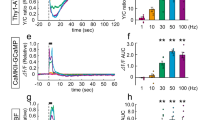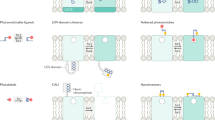Abstract
Glutamate is the most abundant excitatory neurotransmitter in the brain, and it plays an essential and important role in neural functions. Current studies have shown that glutamate can induce neural biophotonic activity and transmission, which may involve the mechanism of photon quantum brain; however, it is unclear whether such a mechanism follows the principle of quantum mechanics. Here we show that the action of glutamate on its receptors leads to a decrease in its quantum energy levels, and glutamate then partially or completely loses its function to further induce the biophotonic activity in mouse brain slices. The reduced quantum energy levels of glutamate can be restored by direct-current electrical discharges and the use of energy transfer of chloroplast photosynthesis; hence, the quantum energy recovered glutamate can again induce significant biophotonic activity. Furthermore, the changes in quantum energy levels of glutamate are related to the exchange and transfer of electron energy on its active hydrogen atom. These findings suggest that the glutamate-induced neural biophotonic signals may be involved in the transfer of the quantum energy levels of glutamate, which implies a quantum mechanism of neurotransmitter action.






Similar content being viewed by others
Data availability statement
All data analysed during this study are included in this published article (and its supplementary information files). All original grey images generated by UBIS system, the processed biophoton grey images and the extracted grey values from the processed biophoton grey images in the regions of interest (ROIs) during the current study are not publicly available due to too large size (> 100 GB) but are available from the corresponding author on reasonable request.
References
Lee, E. J. D., & Williams, K. M. (1990). Chirality. Clinical pharmacokinetic and pharmacodynamic considerations. Clinical Pharmacokinetics. https://doi.org/10.2165/00003088-199018050-00001.
Sell, C. S. (2006). On the unpredictability of odor. Angewandte Chemie International Edition. https://doi.org/10.1002/anie.200600782.
Brookes, J. C. (2017). Quantum effects in biology: Golden rule in enzymes, olfaction, photosynthesis and magnetodetection. Proceedings of the Royal Society A Mathematical Physical and Engineering Sciences. https://doi.org/10.1098/rspa.2016.0822.
Franco, M. I., Turin, L., Mershin, A., & Skoulakis, E. M. C. (2011). Molecular vibration-sensing component in Drosophila melanogaster olfaction. Proceedings of the National Academy of Sciences of the United States of America. https://doi.org/10.1073/pnas.1012293108.
Michaeli, K., Kantor-Uriel, N., Naaman, R., & Waldeck, D. H. (2016). The electron’s spin and molecular chirality-how are they related and how do they affect life processes? Chemical Society Reviews. https://doi.org/10.1039/c6cs00369a.
Wolynes, P. G. (2009). Some quantum weirdness in physiology. Proceedings of the National Academy of Sciences of the United States of America. https://doi.org/10.1073/pnas.0909421106.
Lambert, N., Chen, Y. N., Cheng, Y. C., Li, C. M., Chen, G. Y., & Nori, F. (2013). Quantum biology. Nature Physics. https://doi.org/10.1038/nphys2474.
Tang, R., & Dai, J. (2014). Spatiotemporal imaging of glutamate-induced biophotonic activities and transmission in neural circuits. PLoS ONE. https://doi.org/10.1371/journal.pone.0085643.
Tang, R., & Dai, J. (2014). Biophoton signal transmission and processing in the brain. Journal of Photochemistry and Photobiology B Biology, 139, 71–75. https://doi.org/10.1016/j.jphotobiol.2013.12.008.
Hao, T., & Dai, Y. (2019). Propagation of action potential mediated by microtubules may involve in the neural quantum mechanism. NeuroQuantology. https://doi.org/10.14704/nq.2019.17.02.1975.
Salari, V., Valian, H., Bassereh, H., Bókkon, I., & Barkhordari, A. (2015). Ultraweak photon emission in the brain. Journal of Integrative Neuroscience. https://doi.org/10.1142/S0219635215300012.
Chai, W., Han, Z., Wang, Z., Li, Z., Xiao, F., Sun, Y., et al. (2018). Biophotonic activity and transmission mediated by mutual actions of neurotransmitters are involved in the origin and altered states of consciousness. Neuroscience Bulletin. https://doi.org/10.1007/s12264-018-0215-9.
Jibu, M., Hagan, S., Hameroff, S. R., Pribram, K. H., & Yasue, K. (1994). Quantum optical coherence in cytoskeletal microtubules: Implications for brain function. Biosystems. https://doi.org/10.1016/0303-2647(94)90043-4.
Kumar, S., Boone, K., Tuszyński, J., Barclay, P., & Simon, C. (2016). Possible existence of optical communication channels in the brain. Scientific Reports. https://doi.org/10.1038/srep36508.
Zangari, A., Micheli, D., Galeazzi, R., & Tozzi, A. (2018). Node of Ranvier as an array of bio-nanoantennas for infrared communication in nerve tissue. Scientific Reports. https://doi.org/10.1038/s41598-017-18866-x.
Wang, Z., Wang, N., Li, Z., Xiao, F., & Dai, J. (2016). Human high intelligence is involved in spectral redshift of biophotonic activities in the brain. Proceedings of the National Academy of Sciences of the United States of America. https://doi.org/10.1073/pnas.1604855113.
Tamminga, C. A. (1998). Schizophrenia and glutamatergic transmission. Critical Reviews in Neurobiology. https://doi.org/10.1615/CritRevNeurobiol.v12.i1-2.20.
Olney, J. W., Newcomer, J. W., & Farber, N. B. (1999). NMDA receptor hypofunction model of schizophrenia. Journal of Psychiatric Research. https://doi.org/10.1016/S0022-3956(99)00029-1.
Kantrowitz, J., & Javitt, D. C. (2012). Glutamatergic transmission in schizophrenia: From basic research to clinical practice. Current Opinion in Psychiatry. https://doi.org/10.1097/YCO.0b013e32835035b2.
Gilmour, G., Dix, S., Fellini, L., Gastambide, F., Plath, N., Steckler, T., et al. (2012). NMDA receptors, cognition and schizophrenia—Testing the validity of the NMDA receptor hypofunction hypothesis. Neuropharmacology. https://doi.org/10.1016/j.neuropharm.2011.03.015.
Snyder, M. A., Adelman, A. E., & Gao, W. J. (2013). Gestational methylazoxymethanol exposure leads to NMDAR dysfunction in hippocampus during early development and lasting deficits in learning. Neuropsychopharmacology. https://doi.org/10.1038/npp.2012.180.
Catts, V. S., Lai, Y. L., Weickert, C. S., Weickert, T. W., & Catts, S. V. (2016). A quantitative review of the postmortem evidence for decreased cortical N-methyl-d-aspartate receptor expression levels in schizophrenia: How can we link molecular abnormalities to mismatch negativity deficits? Biological Psychology. https://doi.org/10.1016/j.biopsycho.2015.10.013.
Kosten, L., Verhaeghe, J., Verkerk, R., Thomae, D., De Picker, L., Wyffels, L., et al. (2016). Multiprobe molecular imaging of an NMDA receptor hypofunction rat model for glutamatergic dysfunction. Psychiatry Research Neuroimaging. https://doi.org/10.1016/j.pscychresns.2016.01.013.
Rappeneau, V., Blaker, A., Petro, J. R., Yamamoto, B. K., & Shimamoto, A. (2016). Disruption of the glutamate–glutamine cycle involving astrocytes in an animal model of depression for males and females. Frontiers in Behavioral Neuroscience. https://doi.org/10.3389/fnbeh.2016.00231.
Bardoni, R., Torsney, C., Tong, C. K., Prandini, M., & MacDermott, A. B. (2004). Presynaptic NMDA receptors modulate glutamate release from primary sensory neurons in rat spinal cord dorsal horn. Journal of Neuroscience. https://doi.org/10.1523/JNEUROSCI.4637-03.2004.
Kaniuga, Z., Sochanowicz, B., Zabek, J., & Krystyniak, K. (1978). Photosynthetic apparatus in chilling-sensitive plants—I. Reactivation of hill reaction activity inhibited on the cold and dark storage of detached leaves and intact plants. Planta. https://doi.org/10.1007/BF00384910.
Engel, G. S., Calhoun, T. R., Read, E. L., Ahn, T. K., Mančal, T., Cheng, Y. C., et al. (2007). Evidence for wavelike energy transfer through quantum coherence in photosynthetic systems. Nature. https://doi.org/10.1038/nature05678.
Panitchayangkoon, G., Hayes, D., Fransted, K. A., Caram, J. R., Harel, E., Wen, J., et al. (2010). Long-lived quantum coherence in photosynthetic complexes at physiological temperature. Proceedings of the National Academy of Sciences of the United States of America. https://doi.org/10.1073/pnas.1005484107.
Tempelaar, R., Jansen, T. L. C., & Knoester, J. (2014). Vibrational beatings conceal evidence of electronic coherence in the FMO light-harvesting complex. The Journal of Physical Chemistry B. https://doi.org/10.1021/jp510074q.
Monahan, D. M., Whaley-Mayda, L., Ishizaki, A., & Fleming, G. R. (2015). Influence of weak vibrational-electronic couplings on 2D electronic spectra and inter-site coherence in weakly coupled photosynthetic complexes. The Journal of Chemical Physics. https://doi.org/10.1063/1.4928068.
Yin, Z. H., Dietz, K. J., & Heber, U. (1990). Light-dependent pH changes in leaves of C3 plants—III. Effect of inhibitors of photosynthesis and of the developmental state of the photosynthetic apparatus on cytosolic and vacuolar pH changes. Planta. https://doi.org/10.1007/BF00197120.
Shikanai, T., & Yamamoto, H. (2017). Contribution of cyclic and pseudo-cyclic electron transport to the formation of proton motive force in chloroplasts. Molecular Plant. https://doi.org/10.1016/j.molp.2016.08.004.
Davis, G. A., Kanazawa, A., Schöttler, M. A., Kohzuma, K., Froehlich, J. E., William Rutherford, A., et al. (2016). Limitations to photosynthesis by proton motive force-induced photosystem II photodamage. Elife. https://doi.org/10.7554/eLife.16921.001.
Gray, H. B., & Winkler, J. R. (2003). Electron tunneling through proteins. Quarterly Reviews of Biophysics. https://doi.org/10.1017/S0033583503003913.
Nagel, Z. D., & Klinman, J. P. (2006). Tunneling and dynamics in enzymatic hydride transfer. Chemical Reviews. https://doi.org/10.1021/cr050301x.
Halpin, A., Johnson, P. J. M., Tempelaar, R., Murphy, R. S., Knoester, J., Jansen, T. L. C., & Miller, R. J. D. (2014). Two-dimensional spectroscopy of a molecular dimer unveils the effects of vibronic coupling on exciton coherences. Nature Chemistry. https://doi.org/10.1038/nchem.1834.
Wolke, C. T., Fournier, J. A., Dzugan, L. C., Fagiani, M. R., Odbadrakh, T. T., Knorke, H., et al. (2016). Spectroscopic snapshots of the proton-transfer mechanism in water. Science. https://doi.org/10.1126/science.aaf8425.
Danbolt, N. C. (2001). Glutamate uptake. Progress in Neurobiology. https://doi.org/10.1016/S0301-0082(00)00067-8.
Jiang, J., & Amara, S. G. (2011). New views of glutamate transporter structure and function: Advances and challenges. Neuropharmacology. https://doi.org/10.1016/j.neuropharm.2010.07.019.
Eitan, R., & Lerer, B. (2006). Nonpharmacological, somatic treatments of depression: Electroconvulsive therapy and novel brain stimulation modalities. Dialogues in Clinical Neuroscience, 8, 241–258.
Yrondi, A., Sporer, M., Péran, P., Schmitt, L., Arbus, C., & Sauvaget, A. (2018). Electroconvulsive therapy, depression, the immune system and inflammation: A systematic review. Brain Stimulation. https://doi.org/10.1016/j.brs.2017.10.013.
Acknowledgements
This work was supported by the Sci-Tech Support Plan of Hubei province (2014BEC086) and the research funds of South-Central University for Nationalities (XTZ15014, KTZ20039 and CZP 18003), and partially by the Wuhan frontier project for applied foundational research (2019020701011452), the innovation team fund of National Ethnic Affairs Commission (MZR20002), and the National Natural Science Foundation of China (31640034, 31700911).
Author information
Authors and Affiliations
Contributions
JD conceived and designed the experiments; RZ, TC, and JD performed the experiments and analyzed the data; ZW, and FX provided technical support for UBIS and research materials; JD wrote the manuscript.
Corresponding author
Ethics declarations
Conflict of interest
The authors declare no competing financial interests.
Supplementary Information
Below is the link to the electronic supplementary material.
Rights and permissions
About this article
Cite this article
Han, Z., Chai, W., Wang, Z. et al. Quantum energy levels of glutamate modulate neural biophotonic signals. Photochem Photobiol Sci 20, 343–356 (2021). https://doi.org/10.1007/s43630-021-00022-0
Received:
Accepted:
Published:
Issue Date:
DOI: https://doi.org/10.1007/s43630-021-00022-0




